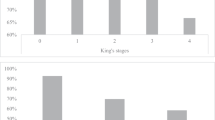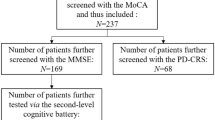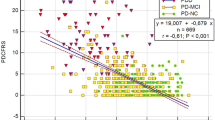Abstract
Background
This study aimed at assessing the cross-sectional and longitudinal clinimetrics and feasibility of the Frontal Assessment Battery (FAB) in non-demented Parkinson’s disease (PD) patients.
Methods
N = 109 PD patients underwent the FAB and the Montreal Cognitive Assessment (MoCA). A subsample of patients further underwent a thorough motor, functional and behavioral evaluation (the last including measures of anxiety, depression and apathy). A further subsample was administered a second-level cognitive battery tapping on attention, executive functioning, language, memory, praxis and visuo-spatial abilities. The following properties of the FAB were tested: (1) concurrent validity and diagnostics against the MoCA; (2) convergent validity against the second-level cognitive battery; (4) association with motor, functional and behavioral measures; (5) capability to discriminate patients from healthy controls (HCs; N = 96); (6) assessing its test–retest reliability, susceptibility to practice effects and predictive validity against the MoCA, as well as deriving reliable change indices (RCIs) for it, at a ≈ 6-month interval, within a subsample of patients (N = 33).
Results
The FAB predicted MoCA scores at both T0 and T1, converged with the vast majority of second-level cognitive measures and was associated with functional independence and apathy. It accurately identified cognitive impairment (i.e., a below-cut-off MoCA score) in patients, also discriminating patients from HCs. The FAB was reliable at retest and free of practice effects; RCIs were derived according to a standardized regression-based approach.
Discussion
The FAB is a clinimetrically sound and feasible screener for detecting dysexecutive-based cognitive impairment in non-demented PD patients.
Similar content being viewed by others

Data availability
Datasets associated with the present study are available upon reasonable request of interested researchers at the following link: https://zenodo.org/record/7774009#.ZCFpDnZBxPZ.
Change history
04 September 2023
A Correction to this paper has been published: https://doi.org/10.1007/s00702-023-02690-x
References
Aiello EN, Rimoldi S, Bolognini N, Appollonio I, Arcara G (2022a) Psychometrics and diagnostics of Italian cognitive screening tests: a systematic review. Neurol Sci 43:821–845
Aiello EN, Gramegna C, Esposito A, Gazzaniga V, Zago S, Difonzo T, Bolognini N (2022b) The montreal cognitive assessment (MoCA): updated norms and psychometric insights into adaptive testing from healthy individuals in Northern Italy. Aging Clin Exp Res 34: 375–382.
Aiello EN, Esposito A, Appollonio I, Bolognini N (2022c) Diagnostic properties of the Frontal Assessment Battery (FAB) in Italian healthy adults. Aging Clin Exp Res 34:1021–1026
Amboni M, Cozzolino A, Longo K, Picillo M, Barone P (2008) Freezing of gait and executive functions in patients with Parkinson’s disease. Mov Disord 23:395–400
American Psychiatric Association (2013) Diagnostic and statistical manual of mental disorders (5th ed.)
Appollonio I, Leone M, Isella V, Piamarta F, Consoli T, Villa ML, Nichelli P (2005) The frontal assessment battery (FAB): normative values in an Italian population sample. Neurol Sci 26:108–116
Barbarotto R, Laiacona M, Frosio R, Vecchio M, Farinato A, Capitani E (1998) A normative study on visual reaction times and two Stroop colour-word tests. Italian J Neurol Sci 19:161–170
Beck AT, Ward CH, Mendelson M, Mock J, Erbaugh J (1961) An inventory for measuring depression. Arch Gen Psychiatry 4:561–571
Benton AL, Varney NR, Hamsher KD (1978) Visuospatial judgment: a clinical test. Arch Neurol 35:364–367
Biundo R, Weis L, Facchini S, Formento-Dojot P, Vallelunga A, Pilleri M, Antonini A (2014) Cognitive profiling of Parkinson disease patients with mild cognitive impairment and dementia. Parkinsonism Relat Disord 20:394–399
Biundo R, Weis L, Pilleri M, Facchini S, Formento-Dojot P, Vallelunga A, Antonini A (2013) Diagnostic and screening power of neuropsychological testing in detecting mild cognitive impairment in Parkinson’s disease. J Neural Transm 120:627–633
Cahn DA, Sullivan EV, Shear PK, Pfefferbaum A, Heit G, Silverberg G (1998) Differential contributions of cognitive and motor component processes to physical and instrumental activities of daily living in Parkinson’s disease. Arch Clin Neuropsychol 13:575–583
Caltagirone C, Gainotti G, Masullo C, Miceli G (1979) Validity of some neuropsychological tests in the assessment of mental deterioration. Acta Psychiatr Scand 60:50–56
Capasso R, Miceli G (2001) Esame Neuropsicologico per l'Afasia: ENPA . Springer Science & Business Media
Carlesimo GA, Caltagirone C, Gainotti G (1996) The mental deterioration battery: normative data, diagnostic reliability and qualitative analyses of cognitive impairment. Eur Neurol 36:378–384
Chou KL, Amick MM, Brandt J, Camicioli R, Frei K, Gitelman D (2010) A recommended scale for cognitive screening in clinical trials of Parkinson’s disease. Movem Disord 25:2501–2507
Chung SJ, Yoo HS, Lee HS, Lee YH, Baik K, Jung JH, Lee PH (2021) Baseline cognitive profile is closely associated with long-term motor prognosis in newly diagnosed Parkinson’s disease. J Neurol 268:4203–4212
Dubois B, Slachevsky A, Litvan I, Pillon B (2000) The FAB: a frontal assessment battery at bedside. Neurology 55:1621–1626
Duff K (2012) Evidence-based indicators of neuropsychological change in the individual patient: relevant concepts and methods. Arch Clin Neuropsychol 27:248–261
D’Iorio A, Maggi G, Vitale C, Trojano L, Santangelo G (2018) “Pure apathy” and cognitive dysfunctions in Parkinson’s disease: a meta-analytic study. Neurosci Biobehav Rev 94:1–10
Fahn S, Elton RL, UPDRS program members (1987) Unified Parkinson’s disease rating scale. In: Fahn S, Marsden CD, Goldstein M, Calne DB (Eds) Recent developments in Parkinson’s disease, pp. 153–163
Federico A, Trentin M, Zanette G, Mapelli D, Picelli A, Smania N, Tamburin S (2017) Diagnosing mild cognitive impairment in Parkinson’s disease: which tests perform best in the Italian population? Neurol Sci 38:1461–1468
Gasca‐Salas, C., Duff‐Canning, S., Armstrong, M. J., Eslinger, P. J., Schneider, R. B., Kennedy, N., ... & Marras, C. (2020). Parkinson disease with mild cognitive impairment: Domain‐specific cognitive complaints predict dementia. Acta Neurologica Scandinavica, 142, 585–596.
Giovagnoli AR, Del Pesce M, Mascheroni S, Simoncelli M, Laiacona M, Capitani E (1996) Trail making test: normative values from 287 normal adult controls. Neurol Sci 17:305–309
Hurtado-Pomares M, Carmen Terol-Cantero M, Sánchez-Pérez A, Peral-Gómez P, Valera-Gran D, Navarrete-Muñoz EM (2018) The frontal assessment battery in clinical practice: a systematic review. Int J Geriatr Psychiatry 33:237–251
Jankovic J, McDermott M, Carter J, Gauthier S, Goetz C, Golbe L, Parkinson Study Group (1990) Variable expression of Parkinson’s disease: a base-line analysis of the DAT ATOP cohort. Neurology 40:1529–1529
Kataoka H, Tanaka N, Saeki K, Kiriyama T, Ueno S (2014) Low frontal assessment battery score as a risk factor for falling in patients with Hoehn-Yahr Stage III Parkinson’s disease: a 2-year prospective study. Eur Neurol 71:187–192
Kim HY (2013) Statistical notes for clinical researchers: assessing normal distribution (2) using skewness and kurtosis. Restor Dent Endod 38:52–54
Kudlicka A, Clare L, Hindle JV (2011) Executive functions in Parkinson’s disease: systematic review and meta-analysis. Mov Disord 26:2305–2315
Kulisevsky J, Pagonabarraga J (2009) Cognitive impairment in Parkinson’s disease: tools for diagnosis and assessment. Mov Disord 24:1103–1110
Larner AJ (2019) New unitary metrics for dementia test accuracy studies. Prog Neurol Psychiatry 23:21–25
Larner AJ (2021b). Paired measures. In: Larner AJ (ed) The 2x2 Matrix. Contingency, Confusion, and the Metrics of Binary Classification, pp. 15–48
Litvan I, Goldman JG, Tröster AI, Schmand BA, Weintraub D, Petersen RC, Emre M (2012) Diagnostic criteria for mild cognitive impairment in Parkinson’s disease: movement disorder society task force guidelines. Movem Disord 27:349–356
Litvan I, Kieburtz K, Tröster AI, Aarsland D (2018) Strengths and challenges in conducting clinical trials in Parkinson’s disease mild cognitive impairment. Mov Disord 33:520–527
Marconi R, Antonini A, Barone P, Colosimo C, Avarello TP, Bottacchi E, Morgante L (2012) Frontal assessment battery scores and non-motor symptoms in parkinsonian disorders. Neurol Sci 33:585–593
Monaco M, Costa A, Caltagirone C, Carlesimo GA (2013) Forward and backward span for verbal and visuo-spatial data: standardization and normative data from an Italian adult population. Neurol Sci 34:749–754
Novelli G, Papagno C, Capitani E, Laiacona M, Cappa SF, Vallar G (1986) Tre test clinici di ricerca e produzione lessicale. Taratura su sogetti normali. Arch Psicol Neurol Psichiatr 47:278–296
Paulwoods S, Tröster AI (2003) Prodromal frontal/executive dysfunction predicts incident dementia in Parkinson’s disease. J Int Neuropsychol Soc 9:17–24
Petkus AJ, Filoteo JV, Schiehser DM, Gomez ME, Hui JS, Jarrahi B, Petzinger GM (2020) Mild cognitive impairment, psychiatric symptoms, and executive functioning in patients with Parkinson’s disease. Int J Geriat Psychiatry 35:396–404
Postuma RB, Berg D, Stern M, Poewe W, Olanow CW, Oertel W, Deuschl, G (2015) MDS clinical diagnostic criteria for Parkinson's disease. Movem Disord 30: 1591–1601.
Puente AN, Cohen ML, Aita S, Brandt J (2016) Behavioral ratings of executive functioning explain instrumental activities of daily living beyond test scores in Parkinson’s disease. Clin Neuropsychol 30:95–106
Rodriguez-Oroz MC, Jahanshahi M, Krack P, Litvan I, Macias R, Bezard E, Obeso JA (2009) Initial clinical manifestations of Parkinson’s disease: features and pathophysiological mechanisms. Lancet Neurol 8:1128–1139
Santangelo G, Raimo S, Siciliano M, D’Iorio A, Piscopo F, Cuoco S, Trojano L (2017) Assessment of apathy independent of physical disability: validation of the Dimensional Apathy Scale in Italian healthy sample. Neurol Sci 38:303–309
Schwab RS, England AC (1969) Projection technique for evaluating surgery in Parkinson’s disease. In: Gillingham FJ, Donaldson MC (eds) Third Symposium on Parkinson’s Disease, pp. 152–157
Skorvanek M, Goldman JG, Jahanshahi M, Marras C, Rektorova I, Schmand B, Violante MR (2018) Global scales for cognitive screening in Parkinson’s disease: critique and recommendations. Movem Disord 33:208–218
Smulders K, van Nimwegen M, Munneke M, Bloem BR, Kessels RP, Esselink RA (2013) Involvement of specific executive functions in mobility in Parkinson’s disease. Parkinsonism Relat Disord 19:126–128
Solca F, Aiello EN, Migliore S, Torre S, Carelli L, Ferrucci R, Poletti B (2022) Diagnostic properties of the frontal assessment battery (FAB) in Huntington’s disease. Front Psychol 13:1031871
Spielberger CD, Gonzalez-Reigosa F, Martinez-Urrutia A, Natalicio LF, Natalicio DS (1971) The state-trait anxiety inventory. Interam J Psychol 5:145–158
Spinnler H, Tognoni G (1987) Standardizzazione e taratura italiana di una batteria di test neuropsicologici. Neurol Sci 6:S1–S120
Varalta V, Picelli A, Fonte C, Amato S, Melotti C, Zatezalo V, Smania N (2015) Relationship between cognitive performance and motor dysfunction in patients with Parkinson’s disease: a pilot cross-sectional study. BioMed Res Int 2015:365959
Varanese S, Perfetti B, Ghilardi MF, Di Rocco A (2011) Apathy, but not depression, reflects inefficient cognitive strategies in Parkinson’s disease. PLoS ONE 6:e17846
Vlagsma TT, Koerts J, Tucha O, Dijkstra HT, Duits AA, van Laar T, Spikman JM (2017) Objective versus subjective measures of executive functions: predictors of participation and quality of life in Parkinson disease? Arch Phys Med Rehabil 98:2181–2187
Wallace ER, Segerstrom SC, van Horne CG, Schmitt FA, Koehl LM (2022) Meta-analysis of cognition in Parkinson’s disease mild cognitive impairment and dementia progression. Neuropsychol Rev 32:149–160
Acknowledgements
The authors are thankful to patients and their caregivers. Roberta Ferrucci was supported from the Ravelli Research Center (CRC) for Neurotechnology and Brain Therapeutics.
Funding
This research was funded by the Italian Ministry of Health to IRCCS Istituto Auxologico Italiano (Ricerca Corrente, project 23C923) and partially supported by the Italian Ministry of Health to Fondazione IRCCS Ca’ Granda Ospedale Maggiore Policlinico.
Author information
Authors and Affiliations
Corresponding author
Ethics declarations
Conflict of interest
V. S. received compensation for consulting services and/or speaking activities from AveXis, Cytokinetics, Italfarmaco, Liquidweb S.r.l., Novartis Pharma AG and Zambon, receives or has received research supports from the Italian Ministry of Health, AriSLA, and E-Rare Joint Transnational Call. He is in the Editorial Board of Amyotrophic Lateral Sclerosis and Frontotemporal Degeneration, European Neurology, American Journal of Neurodegenerative Diseases, Frontiers in Neurology and Exploration of Neuroprotective Therapy. B.P. received compensation for consulting services and/or speaking activities from Liquidweb S.r.l B.P is Associated Editor for Frontiers in Neuroscience. N. T. received compensation for consulting services from Amylyx Pharmaceuticals and Zambon Biotech SA. He is Associate Editor for Frontiers in Aging Neuroscience.
Ethical approval
This study was approved by the Ethics Committees of IRCCS Istituto Auxologico Italiano (I.D.: 23C923_2019) and University of Campania “Luigi Vanvitelli”.
Informed consent
Participants provided informed consent.
Additional information
Publisher's Note
Springer Nature remains neutral with regard to jurisdictional claims in published maps and institutional affiliations.
Supplementary Information
Below is the link to the electronic supplementary material.
Rights and permissions
Springer Nature or its licensor (e.g. a society or other partner) holds exclusive rights to this article under a publishing agreement with the author(s) or other rightsholder(s); author self-archiving of the accepted manuscript version of this article is solely governed by the terms of such publishing agreement and applicable law.
About this article
Cite this article
Aiello, E.N., D’Iorio, A., Solca, F. et al. Clinimetrics and feasibility of the Italian version of the Frontal Assessment Battery (FAB) in non-demented Parkinson’s disease patients. J Neural Transm 130, 687–696 (2023). https://doi.org/10.1007/s00702-023-02624-7
Received:
Accepted:
Published:
Issue Date:
DOI: https://doi.org/10.1007/s00702-023-02624-7



